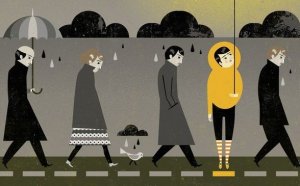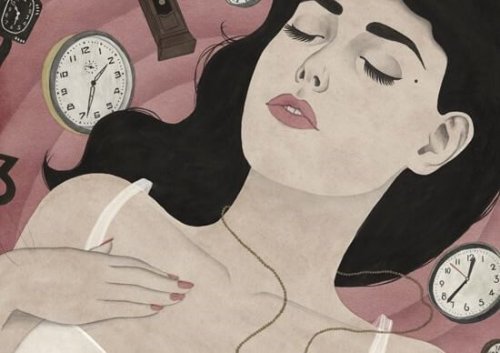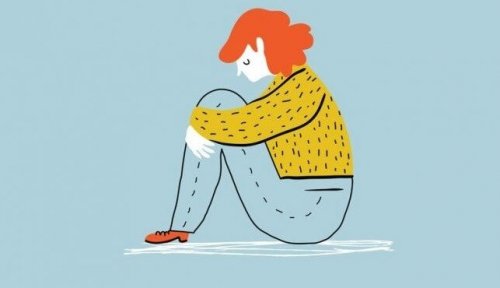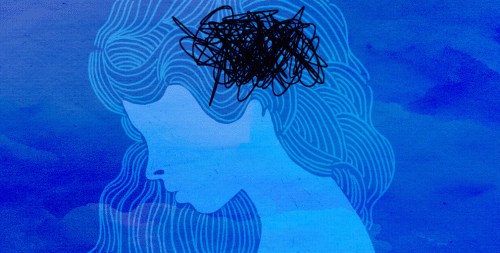5 Differences Between Sadness and Depression

Talking about psychology has become popular recently, but the way we talk about psychology isn’t always correct. We tend to talk about psychology while drawing inappropriate equivalences. One of the classic examples of this is our difficulty to establish the differences between sadness and depression. Therefore, using the word “depression” in popular language has led to confusion about the disease. In fact, it’s even led to some contempt.
Using the word depression instead of sadness or vice versa causes many problems. Some people have found it easier to just say that they’re depressed rather than sad. The first word sounds more technical or scientifically correct, whereas we tend to associate sadness with human frailty.
There are many differences between sadness and depression. The first and most important difference between them is that sadness is temporary. On the other hand, depression is a disease and it needs to be treated. For this reason, it’s important to know the differences between the two.
“Your emotions shouldn’t be paralyzing. They shouldn’t defend themselves. They shouldn’t prevent you from being everything you can be.”
-Wayne W. Dyer-
1. Duration: A decisive factor
The duration of psychological phenomena isn’t something we can measure exactly. Despite this, it’s a fact that the duration of the problem can allow a more precise treatment approach. By definition, an emotion has a short duration.
One of the biggest differences between sadness and depression is that the first is a transient, passing emotion. However, depression is relatively chronic unless a psychologist corrects the problem. A person must experience sadness for six months on a continuous basis, according to diagnostic criteria, for a psychologist to begin to suspect depression in a patient.

2. Abulia: A determining factor
Abulia is basically a difficulty or resistance to acting. When a person is sad, they feel less motivated to perform their normal daily activities. Maybe abulia reduces your social life or you end up spending less time at work or performing tasks that you usually do. However, you’re still relatively active.
A depressed person, on the other hand, is overcome by this discouragement. They disregard their obligations completely and may start to ignore others’ attempts at helping them. They frequently talk about feeling tired, and that fatigue ends up reducing the number of activities they do throughout their day or week. Hence, depression in clinical terms presents a very similar picture to that of a person with an anxiety disorder.
3. Degree of isolation
Another difference between sadness and depression is reflected in the degree of isolation that they’re exhibiting. It’s normal for a sad person to look for close people to talk about how they’re feeling. It’s also normal for them to seek comfort in others, although they can also maintain a degree of social isolation. In this sense, it’ll depend on the person’s personality and coping strategies.
However, a depressed person will constantly reject contact with others. A depressed person keeps their feelings to themselves. They do this even though they don’t feel good being alone and they actually prefer to spend time with others. However, they don’t seek help and gradually become isolated even from their closest friends and family.

4. Level of functionality
A factor that marks a big difference between sadness and depression is the person’s level of functionality. In the case of someone who’s feeling sad, their mood only slightly modifies their daily habits. The person may become less outspoken and more reserved, but they still basically perform all the activities that they normally would throughout the day.
On the other hand, when a person suffers from depression, their usual routine frequently changes. They have a hard time fulfilling their duties at work and at home. They also have difficulty coping with family, social, and emotional obligations. It’s quite common to see a depressed person repeatedly making excuses to cover up for their lack of commitment or failure to follow through. They simply have a hard time adjusting to a “normal” routine.

5. Despair
A person can be sad for different reasons. However, the reason is almost always associated with a loss or a troubling situation that they’re having trouble coping with. Although the person experiences emotional pain, they’re also capable of laughing and looking forward to the future and making new plans. They may not have the answers, but they feel that there’s a potential for a brighter, more hopeful tomorrow.
In the case of a depressed person, all they have is despair. When they look forward to tomorrow, everything is bleak. They don’t have interest, desire, nor or an ability to think about their future. How can they look to the future if the present is already too much for them to handle?
As we can see, there are important and significant differences between sadness and depression. A mental health professional must treat the latter. Depression isn’t a disorder that will just go away on its own. Therefore, it requires specialized intervention.
This text is provided for informational purposes only and does not replace consultation with a professional. If in doubt, consult your specialist.








